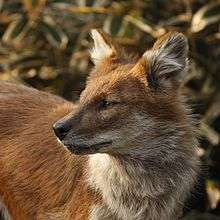豺
See also: 犲
| ||||||||
Translingual
Han character
豺 (radical 153, 豸+3, 10 strokes, cangjie input 月竹木竹 (BHDH), four-corner 24200, composition ⿰豸才)
References
- KangXi: page 1200, character 1
- Dai Kanwa Jiten: character 36500
- Dae Jaweon: page 1662, character 4
- Hanyu Da Zidian: volume 6, page 3908, character 4
- Unihan data for U+8C7A
Chinese
| simp. and trad. |
豺 | |
|---|---|---|
Etymology
The sense "jackal" has arisen because of the unfamiliarity of most modern Chinese speakers with dholes, since wild dholes are now very uncommon in China, and media featuring jackals is far more common than media featuring dholes. Most modern Chinese speakers are only familiar with 豺 as a wild canid that is neither a fox nor a wolf. The commonly accepted name for "jackal" is 胡狼 (húláng).
Glyph origin
| Characters in the same phonetic series (才) (Zhengzhang, 2003) | |
|---|---|
| Old Chinese | |
| 茬 | *zraː, *zraːʔ, *ʔsrɯ, *zrɯ |
| 材 | *zlɯː |
| 才 | *zlɯː, *zlɯːs |
| 財 | *zlɯː |
| 鼒 | *zlɯː, *ʔslɯ |
| 在 | *zlɯːʔ, *zlɯːs |
| 豺 | *zrɯː |
Pronunciation
Definitions
豺

豺
Japanese
Kanji
豺
- This term needs a translation to English. Please help out and add a translation, then remove the text
{{rfdef}}.
Korean
Hanja
豺 • (si) (hangeul 시)
- This term needs a translation to English. Please help out and add a translation, then remove the text
{{rfdef}}.
Vietnamese
Han character
豺: Hán Việt readings: sài (
豺: Nôm readings: sài[1][3][5], rài[4][5]
- This term needs a translation to English. Please help out and add a translation, then remove the text
{{rfdef}}.
Compounds
Compounds
- 豺狼 (sài lang)
References
- Nguyễn et al. (2009).
- Trần (2004).
- Bonet (1899).
- Génibrel (1898).
- Taberd & Pigneau de Béhaine (1838).
This article is issued from
Wiktionary.
The text is licensed under Creative
Commons - Attribution - Sharealike.
Additional terms may apply for the media files.